Keio University
慶應義塾大学 | |
| File:Keio University emblem.svg | |
| Motto | Template:Lang-la |
|---|---|
Motto in English | The pen is mightier than the sword |
| Type | Private research coeducational higher education institution |
| Established | 1858 |
| Founder | Yukichi Fukuzawa |
Academic affiliations | ASAIHL, CoBS, Washington University in St. Louis McDonnell International Scholars Academy[1] |
| Endowment | N/A |
| President | Prof. Akira Haseyama |
Academic staff | full time 2,604[2] |
| Students | 33,825[3] |
| Undergraduates | 28,931[3] |
| Postgraduates | 4,894[3] |
| 1,234[3][4] | |
Other students | 789[2] |
| Location | , Tokyo , Japan |
| Campus | Urban |
| Athletics | 39 varsity teams |
| Colors | Blue and red |
| Nickname | Unicorns, etc. |
| Website | www.keio.ac.jp (engl.) |
| File:Keio University logo.svg | |
Keio University (慶應義塾大学, Keiō Gijuku Daigaku), abbreviated as Keio (慶應) or Keidai (慶大), is a private research university located in Minato, Tokyo, Japan. It is the oldest institute of modern higher education in Japan. Founder Fukuzawa Yukichi originally established it as a school for Western studies in 1858 in Edo. It has eleven campuses in Tokyo and Kanagawa. It has ten faculties: Letters, Economics, Law, Business and Commerce, Medicine, Science and Technology, Policy Management, Environment and Information Studies, Nursing and Medical Care, and Pharmacy.
The university is one of the members of Top Global University Project, funded by the Japanese Ministry of Education, Culture, Sports, Science and Technology .[5] Besides, Keio University is one of the member universities of RU11[6] and APRU, and it is one of only two Japanese universities (alongside the University of Tokyo) to be a member of the World Economic Forum's Global University Leaders Forum.[7]
Its list of alumni and faculties includes three former prime ministers,[8] two astronauts,[8] six international honorary members of American Academy of Arts and Sciences, and a Wolf Prize winner. Meanwhile, Keio University produces the largest number of CEOs of companies listed with the first section of Tokyo Stock Exchange[8][9] and ranks 53rd (in the world) in top 100 Global Executives, according to Times Higher Education's "Alma Master Index 2017".[10]
Overview


Keio traces its history to 1858 when Fukuzawa Yukichi, who had studied the Western educational system at Brown University in the United States, started to teach Dutch while he was a guest of the Okudaira family. In 1868 he changed the name of the school to Keio Gijuku and devoted all his time to education. While Keiō's initial identity was that of a private school of Western studies, it expanded and established its first university faculty in 1890, and became known as a leading institute in Japanese higher education. It was the first Japanese university to reach its 150th anniversary, celebrating this anniversary in 2008.
Keio has leading research centers. It has approximately 30 Research Centers located on its five main campuses and at other facilities for advanced research in Japan.[11] Keio University Research Institute at SFC (KRIS) has joined the MIT and the French INRIA in hosting the international W3C.[12]
Mission
Fukuzawa stated the mission of Keio shown below, which is based on his speech at the alumni party on November 1, 1896.[13]
Keio Gijuku shouldn't be satisfied with being just one educational institution.
Its mission is expected to be a model of the nobility of intelligence and virtue,
to make clear how it can be applied to its family, society, and nation,
and to take an actual action of this statement.
It expects all students being leaders in society by the practice of this mission.
Those sentences were given to students as his will, and considered as the simple expression of Keio's actual mission.[13]
Academic culture
Contributor to Japanese modern education systems
Keio is known for being the first institution to introduce many modern education systems in Japan. The following are the examples:
- Keio is the earliest Japanese school that introduced an annual fixed course fee, designed by Fukuzawa.[14]
- It initially introduced the culture of speech to Japan, which Japan had never had before. It built Japan's earliest speech house Mita Speech House in 1875 as well.[15]
- It is regarded as Japan's first university to accept international students.[16] Keio accepted 2 Korean students in 1881 as its (and also Japan's) first international students. 60 Korean students entered in 1883 and 130 Korean students in 1895.
Dokuritsu Jison
Keio put "Independence and self-respect (独立自尊, Dokuritsu Jison)" as a foundation of its education. This is meant to be physically and mentally independent, and respect yourself for keeping your virtue.[17] Independence and self-respect are also regarded as Fukuzawa's nature and essence of his education.[18]
Hangaku Hankyo
Learning half and teaching half (半学半教, Hangaku Hankyo) is the other unique culture in Keio.[19] During the late Edo period and the early Meiji period, several private prep schools often used students as assistant teachers and it was called "Learning half and teaching half". Keio also had initially used this system. In the early period of such schools of Western studies, there had been many things to learn not only for students but also professors themselves. Hence there had been sometimes the occasions that students who had learned in advance had taught other students and even professors. After the proper legal systems for education had been set up, those situations have disappeared. However, Fukuzawa thought the essence of academia was and is a continuous learning, and knowing more things provides more learning opportunities. Keio respects his thought and put the rule in "Rules in Keio Gijuku (慶應義塾社中之約束, Keio Gijuku Shachu no Yakusoku)" that there shouldn't be any hierarchy between teachers and learners, and all of the people in Keio Gijuku are in the same company. For this reason, there is still a culture in this university that all professors and lecturers are officially called with the honorific of "Kun" but never "Teacher" or "Professor".[20][21]
Shachu no Kyoryoku
Collaboration in a company (社中の協力, Shachu no Kyoryoku) is also a uniqueness of Keio.[22] Fukuzawa stated in 1879 that the Keio's success today is because of the collaboration in its company, and "Collaboration in a company" originally came from this article. People in Keio often think that all of the people related to Keio (e.g. professors, students, alumni and their family members) are the part of their company, thus they should try to help each other like brothers and sisters. This culture has been often seen especially in the alumni organization called Mita-Kai.[23]
History
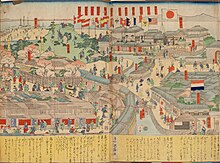

Keio University (慶應義塾大学, Keiō Gijuku Daigaku) was established in 1858 as a School of Western studies located in one of the mansion houses in Tsukiji by the founder Fukuzawa Yukichi.[24] Its root is considered as the Han school for Kokugaku studies named Shinshu Kan established in 1796.[25] Keio changed its name as "Keio Gijuku" in 1868, which came from the era name "Keio"[26] and "Gijuku" as the translation of Private school.[27] It moved to the current location in 1871, established the Medical school in 1873, and the official university department with Economics, Law and Literacy study in 1890.[28]
Keio has been forming its structure in the following chronological order.[29]
| Year | University development |
|---|---|
| 1858 | Keio Gijuku was established |
| 1879 | It rejected an offer to become a national university.[30] Instead of that, it became a vocational school funded by daimyōs including Shimazu clan. |
| 1890 | University department with Faculty of Economics, Faculty of Law, and Faculty of Letters was set up |
| 1906 | Graduate school was set up |
| 1917 | School of Medicine was set up |
| 1920 | It was authorized as a university in the prewar system |
| 1944 | Faculty of Technology was set up |
| 1949 | It was authorized as a university in the post-war system |
| 1957 | Faculty of Business and Commerce was set up |
| 1962 | Graduate School of Business Administration was set up |
| 1981 | Faculty of Science and Technology (reformed from Faculty of Technology) was set up |
| 1990 | Faculty of Environment and Information Studies and Faculty of Policy Management were set up |
| 2001 | Faculty of Nursing and Medical Care was set up |
| 2004 | Law School was set up |
| 2008 | Faculty of Pharmacy was set up |
| 2008 | Graduate School of Media Design was set up |
There have been several notable things in Keio's over 150-year history as shown below.
- Keio launched Hiromoto Watanabe as a first chancellor of the Imperial University (University of Tokyo) in 1886. He is the first chancellor of the officially authorized university in Japan.
- Keio sent 6 students to study abroad in 1899. In the same year, it accepted three international students from India, Qing-dynasty China, and Thailand. Eight international students entered from Taiwan (which had technically been a territory of the Japanese Empire since 1895) in the next year.
- Keio was visited by Bengali poet Rabindranath Tagore where he made a speech in 1916.
- Keio was visited by Albert Einstein where he presented a lecture on the special theory of relativity in 1922.[31]
- It started to accept female students in 1946.
- A paper written by Keio undergraduate student as the first author was placed in the research journal Science in 2006, which had rarely happened to any undergraduate students.[32][33]
- Keio was visited by Prince Charles in 2008.
Presidents
Since the president system was established in 1881, there have been 18 presidents in Keio's history.[34]
| President | Tenure | President | Tenure | President | Tenure | President | Tenure | ||||
|---|---|---|---|---|---|---|---|---|---|---|---|
| 1. | Sadashiro Hamano | 1881–1887 | 7. | Shinzo Koizumi | 1933–1947 | 13. | Saku Sato | 1969–1973 | 19. | Akira Haseyama | 2017- |
| 2. | Nobukichi Koizumi | 1887–1890 | 8. | Seiichiro Takahashi | 1946–1947 | 14. | Hiroshi Kuno | 1973–1977 | |||
| 3. | Tokujiro Obata | 1890–1897 | 9. | Kouji Ushioda | 1947–1956 | 15. | Tadao Ishikawa | 1977–1993 | |||
| 4. | Eikichi Kamata | 1898–1922 | 10. | Fukutaro Okui | 1956–1960 | 16. | Yasuhiko Torii | 1993–2001 | |||
| 5. | Ichitaro Fukuzawa | 1922–1923 | 11. | Shohei Takamura | 1960–1965 | 17. | Yuichiro Anzai | 2001–2009 | |||
| 6. | Kiroku Hayashi | 1923–1933 | 12. | Kunio Nagasawa | 1965–1969 | 18. | Atsushi Seike | 2009– 2017 |
Student body
| Undergraduate | Graduate(Master) | Graduate(Doctor) | Professional | Total | |
|---|---|---|---|---|---|
| Total | 28,931 | 3,115 | 1,234 | 545 | 33,825 |
| Male | 19,557 | 2,281 | 864 | 344 | 23,046 |
| Female | 9,374 | 834 | 370 | 201 | 10,779 |
| International | 438 | 480 | 918 | ||
In 2011, there are 33,825 students in Keio University, with 28,931 undergraduate students and 4,894 graduate students. Although two-thirds of the student body are males, this ratio highly depends on the major (63% of students are female in the Faculty of Letters, for instance).[3]
There are 1072 international students in May 2011, with 438 undergraduate students (1.5% of total undergraduate students), 480 graduate students (9.8% of total graduate students) and 90 students in the exchange program.[35] Korea is the country which provides the most international students with 381, followed by China (300), Taiwan (57), France (42), Indonesia (27), USA (27) and Germany (22).[35]
Student life
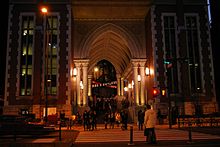
Societies
In Japanese universities, there are student societies called "circles". Although the exact number is not clear, there are over 410 circles in Keio.[36]
Festivals
Keio holds school festivals every year in each campus. The main festival is called "Mita Sai" on Mita campus, which is usually held in late November.[37] Mita Sai includes various activities for not only entertainment but also academic purposes. It is also a research workshop for students on Mita campus.[38] Approximately 200,000 people visit Mita Sai every year.[39]
Athletics
Edward Bramwell Clarke and Tanaka Ginnosuke first introduced Rugby union to Japanese students at Keio University. (The game had been played in the treaty ports of Yokohama and Kobe before that, but not between Japanese teams.)
The interest of Keio's students in baseball stretches back to the early years of the 20th century; and the history of exhibition games was reported internationally. In 1913, an American professional team made of players from the New York Giants and the Chicago White Sox played the Keio team in an exhibition game.[40] In a 1932 exhibition game, the Keio team beat the University of Michigan team which was then touring Japan.[41] Keio's baseball team plays in the Tokyo Big6 Baseball League (six prominent universities in the Tokyo area).
Association football
Keio University association football (soccer) team is currently the most successful team in the Emperor's Cup, despite their last triumph was in 1956. They have won nine times, a number no professional team had ever achieved in the tournament.
Kei-So rivalry
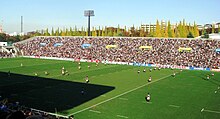
Traditionally, there has been a strong rivalry between Keio and Waseda University. There are annually many matches between 2 universities in several sports, such as baseball, rowing and rugby. These games are called "Kei–So Sen (慶早戦)", or more generally "So–Kei Sen (早慶戦)".
The Kei-So baseball game is especially famous because of its over 100-year history and importance in Japanese baseball history. The most famous Kei-So baseball match was held on 1943/10/16, and it was made into a movie titled "The Last Game – the Final So-Kei Sen -" in 2008.
There are 2 Kei-So baseball game seasons every year and they are usually broadcast by NHK. There is no lecture on all campuses in Keio on the game day because of the students who want to watch this match. Japanese emperors visited Kei-So baseball games 3 times in 1929,1950 and 1994.
Keio and Waseda have been often compared to each other in other general topics, such as their popularity and alumni's successes. In fact, there are many books and magazine articles which compared with these universities.[42][43][44][45]
Keio University is one of the most prestigious universities in Japan. In World rankings, Times Higher Education estimates that Keio is 351–400th place in general academic rankings.
American football
Scandals
In October 2016, six male students from Keio Advertisement Society, a long-standing student club famous for its organisation of the Miss Keio pageant contest, were investigated for gang rape during club activity.[46] An out-of-court settlement was reached and the students were not prosecuted.[47] In May 2018, another three students were arrested for sexual assaults.[48]
In March 2017, a student Tennis club was disbanded after a student death during club activity due to alcohol poisoning. 2 other Keio students died due to over-drinking in 2012 and 2013.[49] In June 2017, the school's election committee unconventionally selected Haseyama Akira, a legal history professor who only won second place at the general election amongst teachers and staffs, to be the school's new president, breaking a 50 years convention.[50]
In late 2019, both the American football team and the cheerleading club suspended club activities for "inappropriate behaviours".[51][52]
In January 2020, it is reported a former secretarial staff to the school president installed camera on a female toilet stall at Mita campus, filming over 1000 videos over 3 months.[53][54]
Academic rankings
| T. Reuters National[55] | Research | 13 | |
|---|---|---|---|
| WE National[56] | Employment | 3 | |
| NBP Greater Tokyo[57][58] | Reputation | 3 | |
| Shimano National[59] | Selectivity | SA | |
| QS Asia (Asia version)[60] | General | 41 | |
| THE World[61] | General | 600-800 | |
| QS World[62] | General | 191 | |
| ARWU World[63] | Research | 301-400 | |
| ENSMP World[64] | Alumni | 3 | |
| Social Sciences & Humanities | |||
|---|---|---|---|
LAW | |||
| Asahi National[65] | Research | 2 | |
| Natural Sciences & Technology | |||
Engineering | |||
| QS World[66] | General | 179 | |
Keio ranks 53rd in the world in the Times Higher Education's Alma Mater Index.[71] It ranks 34th globally in the Center for World University Rankings (CWUR) and 3rd in Asia.[72] Keio is ranked at 58th of the Reuters Top 100 innovative universities worldwide.[73] British Quacquarelli Symonds (QS) company estimates that Keio is ranked the 192nd in QS World University Rankings 2017/18.[74] It is ranked the 45th in QS World University Ranking 2017/18 for Graduate Employability Ranking. In the Asian University Ranking (2015), Quacquarelli Symonds also ranked Keio as 37th in Asia.[74] The Academic Ranking of World Universities (2015), which is compiled by Shanghai Jiao Tong University, ranks Keio 301–400 in the world and 37 in Asia.[75] Keio, with Waseda University, is one of the prominent private universities within Japan.
Research performance
According to Thomson Reuters, Keio is the 10th best research university in Japan, and it's the only private university within Top 15.[55] In addition, Weekly Diamond reported that Keio has the 8th highest research standard in Japan in terms of research fundings per researchers in COE Program, and it's also the only private university within Top 10.[76] Asahi Shimbun summarized the amount of academic papers in Japanese major legal journals by university, and Keio was ranked 2nd during 2005–2009.[65] Accordingly, Keio is a prominent research university within Japan.
In economics, according to Asahi Shimbun, Keio's been ranked 7th in Japan in the economic research ranking during 2005–2009.[77] More recently, Repec in January 2011 ranked Keio's Economic department as Japan's 6th best economic research university.[78] Keio has provided 3 presidents of Japanese Economic Association in its 42-year history, and this number is 5th largest.[79]
In addition, Nikkei Shimbun on 2004/2/16 surveyed about the research standards in Engineering studies based on Thomson Reuters, Grants in Aid for Scientific Research and questionnaires to heads of 93 leading Japanese Research Centers, and Keio was placed 8th (research planning ability 4th/informative ability of research outcome 3rd) in this ranking.[80]
Business
Keio ranks second in Japan, for the number of alumni holding CEO positions in Fortune Global 500 companies, according to Mines ParisTech: Professional Ranking of World Universities.[64] Keio is also ranked 1st in Japan for the number of alumni generally holding executive positions (when positions like COO, CFO, CIO etc. are included along with the CEO position) in listed companies of Japan, and this number per student (probability of becoming an executive) is also top.[81][82]
Keio Business School is Japan's first business school and one of four Japanese schools holding The Association to Advance Collegiate Schools of Business (AACSB) accreditation.[83] Keio was ranked No. 1 in Japan by Nikkei Shimbun.[84] Eduniversal also ranked Keio as top in Japan (75th in the world).[85] In Eduniversal Keio is one of only 3 Japanese schools categorized in "Universal Business schools with major international influence". In 2012, the Keio Business School became founding member of the university alliance Council on Business & Society that consists of Tuck School of Business from USA, University of Mannheim Business School from Germany, ESSEC Business School from France, Fudan University from China, Fundação Getúlio Vargas from Brazil and Keio Business School.
According to the Weekly Economist's 2010 rankings and the PRESIDENT's article on 16 October 2006, graduates from Keio University have the 3rd best employment rate in 400 major companies, and the alumni's average salary is the 3rd best in Japan.[86][87]
Accounting
As an extension of Keio's strong business focus, for over 30 years, Keio graduates have been ranked first in Japan in the number of successful national CPA exam applicants.[11]
Medicine
Keio has been influential in Japanese medical societies as well. In fact, there have been 4 presidents of Japan Medical Association related to this university (2 Alumni and 2 professors).[88] This number is the 2nd largest among Japanese medical schools.[89] Keio is one of 2 Japanese universities which provided a president of World Medical Association.[90]
Law
Keio's law faculty is typically ranked among the best in all of Japan along with the University of Tokyo, University of Kyoto, Chuo University, and Hitotsubashi University. In 2010 and 2015, Keio University Law School ranked highest among all Japanese universities for Bar Exam passage rate.[91] Furthermore, the number of Members of Parliament who graduated Keio has been 3rd in Japan.[77][92]
Popularity and selectivity
Keio is a popular university in Japan, often considered one of Japan's top two private university alongside Waseda University, their eternal equal and rival. The number of applicants per place was 11.7 (48260/4098) in the 2011 undergraduate admissions.[93] Its entrance difficulty is usually considered as top with Waseda among 730 private universities.[94][95][96]
Nikkei BP has been publishing a ranking system called "Brand rankings of Japanese universities" every year, composed by the various indications related to the power of brand, in which Keio was top in 2014, and ranked second in 2015 and 2016 in Greater Tokyo Area.[97] Webometrics (2008) also ranks Keio University as 3rd in Japan, 11th in Asia, and 208th in the world for quantity and quality of web presence and link visibility.[98]
In a unique ranking, TBS ranked Japanese universities by the questionnaire of "Which university student do you want to have as your boyfriend?" to 300 girls in Shibuya, and Keio was ranked 1st in this ranking .[99]
Finance
| Revenues | (yen in millions) | ratio | Expenses | (yen in millions) | ratio |
|---|---|---|---|---|---|
| Tuition and fees | 49,204 | 24.97% | Compensation and benefits | 65,270 | 33.12% |
| Investment return | 4,170 | 2.12% | Education & Research | 52,148 | 26.46% |
| Capital gain | 20,817 | 10.56% | Investment | 32,923 | 16.71% |
| National appropriation/Grants(Direct) | 17,082 | 8.67% | Repayment of debt | 13,236 | 6.72% |
| Medical care | 48,274 | 24.50% | |||
| Debt loan | 11,680 | 5.93% | |||
| Endowments | 5,475 | 2.78% | |||
| Total | 197,061 | 100.00% | Total | 197,061 | 100.00% |
According to Keio's financial report, there was operating revenue of 197 billion yen in 2010.[100] The top three largest incomes were from "tuition and fees", "medical care" and "capital gain", with 49 billion yen, 48 billion yen and 21 billion yen respectively. The amount of endowments in 2010 was about 5 billion yen. Keio is known as having one of the largest financial endowments of any Japanese university.[101]
On the other hand, the top 3 largest expenses in 2010 were "Compensation and benefits", "Education & Research" and "Investment", with 65 billion yen, 52 billion yen and 33 billion yen respectively. The total asset value in 2010 was about 364 billion yen with increase of 5 billion yen. In addition, the total amount of assets under management was approximately 109 billion yen in 2010, composed by mainly cash, deposit with banks and marketable securities.[100]
Tuition fees
| Undergraduate | 4 years in Total (yen) | Per year (yen) |
|---|---|---|
| Social Science & Humanities | 4,440,000 | 1,110,000 |
| Natural Science & Engineering | 6,280,000 | 1,570,000 |
| SFC | 5,320,000 | 1,330,000 |
| School of Medicine | 14,440,000 | 3,610,000 |
| Graduate | 2 years in Total (yen) | Per year (yen) |
| Social Science & Humanities | 1,380,000 | 690,000 |
| Natural Science & Engineering | 1,965,000 | 983,000 |
| SFC | 2,071,000 | 1,035,000 |
| School of Medicine | 2,625,000 | 1,313,000 |
The university tuition fee system in Japan is different from other countries and very complicated. In most Japanese universities, there are more payment requirements in the first year such as "entrance fees", and less in the rest of the years. There are several types of fees (some require to pay only once and some require to pay once or twice every year) and so-called "course fee" is officially only one of those fees.
In Keio University, Tuition fees vary and depend on the course. Social Science & Humanity studies require the least fees with approximately 1,110,000 yen per year, and School of Medicine requires the most expensive fees with about 3,610,000 yen per year.[102] The tuition fees in graduate school are much less than those for undergraduate studies, as 690,000 yen per year for Social Science & Humanities and 1,313,000 yen per year for School of Medicine.[103]
Although it is acceptable to pay twice with half in spring and half in autumn, the "entrance fee" is necessary to be paid before enrollment. The entrance fee for undergraduate study is 200,000 yen and the one for graduate study is 310,000 yen.[102][103]
Scholarship/loan
| 2008 | number of students | ratio | average amount (yen) |
|---|---|---|---|
| Total using scholarship/loan | 9,764 | 30.25% | |
| Total of using scholarship funded by Keio | 3,000 | 9.30% | 300,000 |
| International students (undergraduate) | 397 | appx. 100% | 259,942 |
| International students (graduate) | 359 | appx. 75% | 517,473 |
There are many students who receive additional financial support. For example, in 2008, there were 9,764 students (about 30% of all students) who used either scholarships or loans.[104] Additionally, Keio funds over 3,000 students who receive, on average, scholarships of 300,000 yen.[104]
Organization
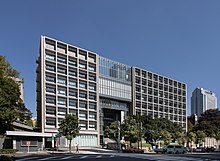
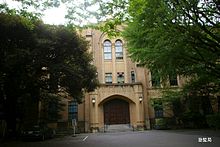
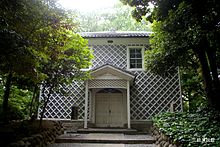

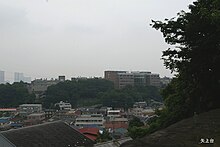
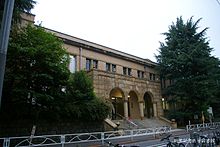

Faculties
Keio has ten undergraduate faculties, which cover a wide range of academic fields, with each operating independently and offering broad educational and research activities. The faculties are:
- Faculty of Letters (800)
- Faculty of Economics (1200)
- Faculty of Law (1200)
- Faculty of Business and Commerce (1000)
- School of Medicine (112)
- Faculty of Science and Technology (932)
- Faculty of Policy Management (425)
- Faculty of Environment and Information Studies (425)
- Faculty of Nursing and Medical Care (100)
- Faculty of Pharmacy (210)
Graduate schools
- Graduate School of Letters
- Graduate School of Economics
- Graduate School of Law
- Graduate School of Human Relations
- Graduate School of Business and Commerce
- Graduate School of Medicine
- Graduate School of Science and Technology
- Graduate School of Business Administration
- Graduate School of Media and Governance
- Graduate School of Health Management
- Graduate School of Pharmaceutical Sciences
- Law School
- Graduate School of Media Design
- Graduate School of System Design and Management
Media centers
Keio's Media Centers, with combined holdings of over 4.58 million books and publications, are one of the largest academic information storehouses in the country.[105]
- Mita Media Center
- Hiyoshi Media Center
- Media Center for Science and Technology
- Shinanomachi Media Center
- SFC Media Center
Information technology centers
- ITC Headquarters
- Mita ITC
- Hiyoshi ITC
- Shinanomachi ITC
- Science & Technology ITC
- Shonan Fujisawa ITC
Affiliated schools
- Keio Yochisha Elementary School
- Keio Futsubu School (Boys Junior High School)
- Keio Chutobu Junior High School
- Keio Shonan Fujisawa Junior and Senior High School
- Keio Senior High School
- Keio Shiki Senior High School
- Keio Girls Senior High School
- Keio Academy of New York (High School)
Language education
- Japanese Language Program
- Keio Foreign Language School
Others
- Keio Marunouchi City Campus (KMCC)
Hospital and rehabilitation center
Keio University Hospital is one of the largest and most well-known general hospitals in Japan,[citation needed] the number of surgeries for carcinoma uteri in 2007 was top and the one for lung cancer was third among all university hospitals.[106] and is also a famous teaching hospital. The number of trainee doctors who selected Keio as their first choice training hospital was 30 (33rd) among all Japanese teaching hospitals in 2010.[107] Established in 1920, it has over 1,000 beds, a leading laboratory, and research and medical information divisions.[11]
- Keio University Hospital (慶應義塾大学病院 or 慶應大学病院)
- Tsukigase Rehabilitation Center (月が瀬リハビリテーションセンター)
Campuses
There are eleven campuses.
- Mita Campus (Mita, Minato, Tokyo)
- Hiyoshi Campus (Yokohama, Kanagawa), home of the Hiyoshi tunnels
- Yagami Campus (Yokohama, Kanagawa)
- Shinanomachi Campus (Shinjuku)
- Shonan Fujisawa Campus (Fujisawa, Kanagawa, aka SFC) designed by Fumihiko Maki
- Shiba Kyoritsu Campus (Minato ward, Tokyo)
- Shin-Kawasaki Town Campus (Kawasaki, Kanagawa)
- Tsuruoka Town Campus of Keio (Tsuruoka, Yamagata, aka TTCK)
- Urawa Kyoritsu Campus (Urawa, Saitama)
- Keio Osaka Riverside Campus (Osaka)
- Keio Marunouchi City Campus (Tokyo)
Alumni and professors
Some of the prominent Keio alumni include: Japanese Prime Ministers Junichiro Koizumi (2001–2006), Ryutaro Hashimoto (1996–1998), and Tsuyoshi Inukai (1931–1932). Dozens of other alumni have been cabinet members and governors in the post-war period.[108] Its alumni include 230 CEOs of major companies and 97 CEOs of foreign affiliated companies (both highest in Japan).[11] Keio has over 320,000 alumni in 866 alumni associations.[11][109]
Politicians



- Junichiro Koizumi, the 87th/88th/89th Prime Minister of Japan (2001–2006), the 20th President of Liberal Democratic Party of Japan (Economics, 1967)
- Ryutaro Hashimoto, the 82nd/83rd Prime Minister of Japan (1996–1998), the 17th President of Liberal Democratic Party of Japan (Law, 1960)
- Tsuyoshi Inukai, the 29th Prime Minister of Japan (1931–1932), the 6th President of Rikken Seiyūkai
- Ichirō Ozawa, Former President of Democratic Party of Japan, Former Secretary General of Liberal Democratic Party of Japan (Economics, 1967)
- Tamisuke Watanuki, President of People's New Party, Former Speaker of The House of Representatives of Japan (Economics, 1950)
- Toshiko Hamayotsu, Minister for Global Environmental Issues and Director-General of Environment Agency of Government of Japan (1994).[110]
- Kenji Kosaka, Minister of Education, Culture, Sports, Science and Technology (Law, 1968)
- Jirō Kawasaki, Minister of Health, Labour and Welfare (Business and Commerce, 1971)
- Andrew Thomson, Minister for Sport and Tourism and Minister Assisting the Prime Minister for the Sydney 2000 Games in the Australian Government 1997 – 1998
- Shigefumi Matsuzawa, Governor of Kanagawa (Law, 1982)
- Akihiko Noro, Governor of Mie (Science and Technology, 1969)
- Genjirō Kaneko, Governor of Nagasaki (Letters, 1968)
- Motohiro Ōno,Governor of Saitama(Law, 1987)
- Hiroshi Nakai, Chairman of the National Commission on Public Safety, Minister of State for Disaster Management and the Abduction Issue (Economics, 1969)
- Yūzan Fujita, Governor of Hiroshima (Business and Commerce, 1972)
- Ryōzō Hiranuma, Mayor of Yokohama, Order of Culture
- Keiichi Inamine, Governor of Okinawa (Economics, 1957)
- Masaharu Ikuta, President of Japan Post, Former CEO of Mitsui O.S.K. Lines (Economics, 1957)
- Yukio Ozaki, Mayor of Tokyo, Minister of Justice, Education, "Father of parliamentary politics" in Japan.[111]
- Nobuteru Ishihara, Minister of Land, Infrastructure and Transport, Minister of State for Administrative and Regulatory Reform, Candidate for the LDP presidency 2008
- Heitaro Inagaki, Minister of Economy, Trade and Industry (Economics, 1913)
- Banri Kaieda, Minister of Economy, Trade and Industry (Law)
- Hirofumi Nakasone, Minister for Foreign Affairs
- Yoshio Sakurauchi, Minister for Foreign Affairs
- Kamata Eikichi, Minister of Education[112]
- Hidenao Nakagawa, Chief Cabinet Secretary
- Mitsuo Horiuchi, Minister of International Trade and Industry
- Yoshiyuki Kamei, Minister of Agriculture, Forestry and Fisheries
- Seiichi Ota, Minister of Agriculture, Forestry and Fisheries
- Ryu Shionoya, Minister of Education, Science and Technology
- Kosuke Hori, Minister of Education
- Fusanosuke Kuhara, Minister of communications
- Shigeru Ishiba, Minister of Defense, Minister of Agriculture, Forestry and Fisheries (Law, 1979)
- Kazuyoshi Kaneko, Minister of Land, Infrastructure, Transport and Tourism and Minister for Ocean Policy
- Takeo Kawamura, Minister of Education, Science and Technology and Chief Cabinet Secretary
- Koichi Yamamoto, Minister of Environment
- Akira Amari, Minister of Economy, Trade and Industry and Minister of State in charge of Administrative Reform
- Tatsuya Ito, Minister of State for Financial Services
- Tadamori Oshima, Minister of Agriculture
- Takeo Hiranuma, Minister of Transport and Minister of Economy, Trade, and Industry
- Akira Nagatsuma, Minister of Health, Labour and Welfare, Minister of State for Pension Reform
- Masajuro Shiokawa, Chief Cabinet Secretary of Japan
- Heizō Takenaka, Minister of Internal Affairs and Communications (Emeritus Prof.)
- Wataru Takeshita, Minister for Reconstruction
- Jon Richards, Wisconsin legislator
- Sommai Hoonrakoon, Minister of Finance (Thailand) (Economics, 1942)[113]
- Set Aung – politician, economist and management consultant, incumbent Deputy Planning and Finance Minister of Myanmar
Public servants, international organizations
- Takeshi Kasai, WHO Regional Director of Western Pacific (medicine, 1990)[114][115]
- Shigeru Omi(undergraduate atten.), WHO Regional Director of Western Pacific,[114][115]
- Kiyoko Okabe, the first female justice of Supreme Court, Japan (Master, Law, 1974)[116]
- Taro Takemi, president of the World Medical Association and Japan Medical Association (MD, medicine, 1930)
- Ichirō Fujisaki, Diplomat, Chairman of Executive Committee of United Nations High Commissioner for Refugees (Economics (dropout), 1969)
Central Bank Governors
- Shigeaki Ikeda, Minister of Finance, Commerce and Industry, Governor of The Bank of Japan
- Makoto Usami, Governor of The Bank of Japan
- Tarisa Watanagase (Thai), Governor of the Bank of Thailand, 2006–2010 (Economics)
- Chang Kia-ngau (Economics, 1906-1908), Governor of the Central Bank of Republic of China [117]
Astronauts
- Chiaki Mukai, JAXA astronaut (MD, medicine, 1988)
- Akihiko Hoshide, JAXA astronaut
Finance
- Taizo Nishimuro, Chairman and CEO of Tokyo Stock Exchange, Former CEO of Toshiba Corporation (Economics 1961)
- Koichiro Miyahara, Chairman and CEO of Tokyo Stock Exchange[118]
- Atsushi Saito, Chairman and CEO of Tokyo Stock Exchange,[118]
- Shigeharu Suzuki, President and CEO of Daiwa Securities Group (Economics 1971)
Media
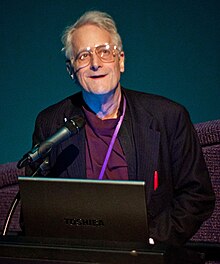
- Tōru Shōriki, owner of The Yomiuri Shimbun (Economics, 1942)
- Tarō Kimura, journalist (Law, 1964)
- Akira Ikegami, journalist (Economics, 1973)
- Kazuhiko Torishima, president of Hakusensha (Law, 1976)
Other business people
- Akio Toyoda, President and CEO Toyota Motor Corporation 2009–current
- Yutaka Asoh, later known as Yutaka Katayama, the first president of the U.S. operations of Nissan Motors (Economics 1935)
- Osamu Nagayama (born 1947), CEO of Chugai Pharmaceutical and Chairman of Sony Corporation
- Katsuaki Watanabe, President of Toyota Motor Corporation (Economics 1964).[119]
- Yuzaburo Mogi, Chairman and CEO of Kikkoman Corporation (Law 1958)
- Yotaro Kobayashi(Economics,1956), chairman of Fuji Xerox, former chairman of Japan Association of Corporate Executives[120]
- Shinzo Maeda, President and CEO of Shiseido (Letters 1970)
- Hidetaka Miyazaki, President of FromSoftware[121]
- Ichizō Kobayashi, Founder of Hankyu Railway and the Takarazuka Revue, Minister of Commerce and Industry in the 1940 Konoe Cabinet
- Nobutada Saji, Chief executive of Suntory Ltd., the wealthiest individual in Japan as of 2004 by Forbes
- Akira Mori, President and CEO of Mori Trust, the fourth-wealthiest person in Japan as of 2013 by Forbes
- Keiichi Ishizaka, chairman and CEO, Warner Music Japan Inc. (Business and Commerce, 1968) – 2009 Medal of Honor Awardee
- Lee Jae-yong, vice chairman of Samsung Electronics (MBA 1995) – The 3rd wealthiest person in South Korea and the most powerful Korean by 2014's Forbes Magazine
- Teruaki Yamagishi, received the 4th Class, Order of the Rising Sun Gold Rays with Rosette in 2008
- Takeo Shiina, Chairman of IBM Japan, former Chairman of Japan Association of Corporate Executives (Science and Technology 1951)
Academia
Dozens of alumni and professors have been elected as academy members or been in important positions.[122]
- Yukichi Fukuzawa (founder), First President of Japan Academy,the current portrait of 10,000-yen notes
- Kitasato Shibasaburō (first dean of Keio University School of Medicine), Member of Japan Academy, fellow of Royal Society of London,[123] nominated for Nobel Prize[124]
- Genichi Kato (professor), Nominated for Nobel Prize, Member of Japan Academy[124]
- Shinzo Koizumi(politics,1910), Member of Japan Academy,best known as the educator of His Majesty the Emperor Emeritus at the age of the prince. Received an honorary doctorate from Columbia University [125][126]
- Keisuke Suzuki (professor), Member of Japan Academy [127]
- Sho-Chieh Tsiang (undergraduate atten.), member of Academia Sinica[128]
- Atsuo Iiyoshi (engineering, 1960), emeritus professor of Kyoto University, honorary doctorate of Russian Academy of Sciences[129]
- Seiichiro Takahashi (politics, 1908), Member of Japan Academy, Minister of Education
- Toshihiko Izutsu (literature, 1937), Member of Japan Academy
- Akira Hayami (economics, 1954), Member of Japan Academy , coined the notion of "Industrious Revolution" [130][131]
- Tokuzo Fukuda (prof.), Member of Japan Academy [132]
- Kazui Tashiro (ph.D in economics), Member of Japan Academy,[122]
- Junzaburo Nishiwaki (economics, 1917), nominated for Nobel Prize, International Honorary Member of American Academy of Arts and Sciences [133]
- Tsuneo Tomita (medicine, 1932), International Honorary Member of American Academy of Arts and Sciences, Member of Japan Academy, Professor Emeritus of Yale University[134][135][136]
- Osamu Saito (Hitotsubashi University) (economics, 1968), member of Japan Academy, International Honorary Member of American Academy of Arts and Sciences, Professor Emeritus of Hitotsubashi University ,[137][138][139]
- Ryogo Kubo (professor), the Boltzmann Medal, Order of Culture, member of Japan Academy, International Honorary Member of American Academy of Arts and Sciences[140][141][142]
- Mikinosuke Miyajima (professor), International Honorary Member of American Academy of Arts and Sciences, Japan's representative for League of Nations Health Organization.[143]
- David J. Farber, fellow, American Association for the Advancement of Science (the Distinguished Professor and Co-Director of Cyber Civilization Research Center)[144]
- Hiromoto Watanabe (1865), the first President of Tokyo Imperial University[145]
- Hamao Arata(1869), the third and eighth President of Tokyo Imperial University[145]
- Sahachiro Hata (Prof.), nominated for Nobel Prize,[124] member of Japan Academy,[146]
- Masayuki Amagai (medicine, 1985), International Member of National Academy of Medicine[147]
- Masaharu Tsuchiya (medicine, 1953), member of Académie Nationale de Médecine,[148]
- Masaki Kitajima (medicine, 1966), Honorary Fellow of Royal College of Surgeons of England, member of European Academy of Science[149]
- Ken Sakamura (engineering, 1974), emeritus professor of University of Tokyo, Japan Academy Prize (academics), the creator of the real-time operating system architecture TRON project[150]
- Takao Suzuki (sociolinguist) (literature, 1950),former professor of Yale University[151]
- Toshio Ito(Medicine), best known for discovery of Ito cell, Japan Academy Prize (academics),[152][153]
- Hideyuki Okano(medicine,1983), the first in the world to produce transgenic marmosets(Callithrix jacchus) with germline transmission.[154] Besides, he is to conduct the world's first clinical test in which artificially derived stem cells will be used to treat patients with spinal cord injuries.[155][155]
- Toju Hata (medicine,1934), Japan Academy Prize (academics), best known for the discovery of Mitomycin C,[156][157]
- Yoshitaka Tanimura,derived Hierarchical equations of motion with Ryogo Kubo, Professor of Kyoto University, Humboldt Prize Winner (Sci.and Tech)[158]
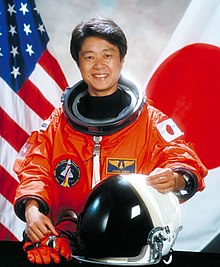
- Katsuhiko Mikoshiba(medicine,1969), Emeritus Professor of The University of Tokyo ,first cloned in the world of the IP3 receptor in laboratory, which was found to play an important role in many biological functions such as body development and brain plasticity. Legion of Honor, honorary doctorate from Karolinska Institute(2011),[159] Japan Academy Prize (academics)[160]
- Kuniaki Tatsuta(Ph.D,1969), the first in the world to synthesize totally four big Antibiotics (aminoglycoside, -lactam, macrolide and tetracycline antibiotics), which was accomplished by using carbohydrates as chiral sources in their laboratories. Japan Academy Prize (academics),[161][162]Ernest Guenther Award(2013)[163]
- Hikohjiro Kaneko (Ph.D in Literature,1946), Japan Academy Prize (academics)[164]
- Tatsuya Sakamoto (Economics,1979), Japan Academy Prize (academics)[165]
- Masayoshi Tomizuka, professor in Control Theory in Department of Mechanical Engineering, and director of Mechanical Systems Control Laboratory, University of California, Berkeley. He holds the Cheryl and John Neerhout, Jr., Distinguished Professorship Chair, and has supervised more than 90 Ph. D. students to completion, many of which have become professors in universities in USA, Taiwan, etc., prestigious for the research in the field of Mechanical Engineering. (B.S. and M.S. degrees, Mechanical Engineering, 1968 and 1970)
- Shosuke Okamoto(medicine,1941), first synthesized in 1962 Tranexamic acid with Utako Okamoto. Emeritus professor of Kobe University[166]
- Tatsuji Nomura(medicine, 1945), a pioneer in the development of laboratory animals with the aim of assuring reproducibility of experimental results in medical research. Medal of Honor With Purple Ribbon from Japanese Government(1984).[167]
- Fumiko Yonezawa (Emeritus), The first female President of The Physical Society of Japan[168]
- Shuichi Nosé (professor), famous for the Nosé–Hoover thermostatt [169]
- Yasuhiro Matsuda, professor of international politics at the University of Tokyo (Law)
- Yoshihiro Tsurumi, professor of international business at Baruch College of the City University of New York (Economics)
- Jun Murai, "The Father of The Internet" in Japan, Legion of Honor (2018) (PhD, Engineering)[170]
- Kohei Itoh, Successfully generated and detected quantum entanglement between electron spin and nuclear spin in phosphorus impurities added to silicon with Dr. John Morton at Oxford University. This is the world's first successful generation.(Science and Technology)[171]
- Yasuhiro Koike, Developed the High-bandwidth graded-index plastic optical fiber.[172]
He is thought as one of the Nobel Prize candidates in Physics in terms of the achievement of plastic optical fiber.(Sci. and Tech)[173][174] - Masaru Tomita, Established the metabolomics analysis by using the CE-MS.(Environment and Information Studies)
- Eitaro Noro, Marxian Economist.The Author of "History of the Development of Japanese Capitalism"(1930) (Native:「日本資本主義発達史講座」), Iwanami Shoten,Tokyo[175]
Art
- Shotaro Yasuoka, Member of Japan Art Academy
- Yamamoto Kenkichi,Member of Japan Art Academy
- Hiroshi Sakagami, Member of Japan Art Academy
- Shusaku Endo(Literature,1948) Akutagawa Prize, Order of Culture ,honorary doctorate from Georgetown University[176]
- Daigaku Horiguchi, Poet, Translator, Member of Japan Art Academy
- Yone Noguchi (undergraduate attendee, professor), poet[177]
- Tanaka Chikao, Member of Japan Art Academy(Literature)
- Rofū Miki (undergraduate attendee), poet[178]
- Gozo Yoshimasu, Member of Japan Art Academy
- Jun Etō, Member of Japan Art Academy , literary critic
- Mantaro Kubota, Member of Japan Art Academy
- Haruo Sato (novelist), Member of Japan Art Academy (Literature)
- Kafū Nagai, Member of Japan Art Academy, Order of Culture(Prof.)
- Shinobu Orikuchi, Ethnologist (Emeritus prof.)
- Takitaro Minakami, author (Economics)
- Yojiro Ishizaka, author (Literature)
- Sakutarō Hagiwara, Poet
- Yumeno Kyūsaku, Surrealistic detective novelist
- Kazuki Kaneshiro, Zainichi Korean novelist
- Kôhei Tsuka, playwright, theater director, and screenwriter
- Adebayo Adewusi, Lawyer and Public Administrator.
- Yoshio Taniguchi(Engineering,1960), member of Japan Art Academy. Architect best known for his redesign of the Museum of Modern Art in New York City which was reopened November 20, 2004 [179]
- Fumihiko Maki (Keio High school,undergraduate atten.),International Honorary Member of American Academy of Arts and Sciences, Wolf Prize in Arts,[180][181][182]
Others
- Ryuichi Kuki, Envoy Extraordinary and Minister Plenipotentiary, Governor of The Imperial Museum (The Tokyo National Museum, Kyoto National Museum, and Nara National Museum), The Father of Syuzo Kuki (1874)
- Theodor Holm "Ted" Nelson, Computer architect, visionary, and contrarian (PhD, Media and Governance, 2002)
- Yuichi Motai, professor of Virginia Commonwealth University(Computer Engineering>, NSF Career Award (2011)
- Wataru Kamimura, professional shogi player (the first university graduate to become shogi professional) (Science and Technology / mathematical sciences, 2013)
- Joi Ito, former director of the MIT Media Lab, professor at Massachusetts Institute of Technology and Harvard University (PhD, Media and Governance, 2018)
Gutenberg Bible
The only copy held outside Europe or North America is a first volume facsimile of the Gutenberg Bible (Hubay 45) at Keio University. Purchased by the university in 1996, from Maruzen booksellers who originally purchased the copy at auction in 1987 for US$5.4 million.[183][184]
The Humanities Media Interface Project (HUMI) at Keio University is known for its high-quality digital images of Gutenberg Bibles and other rare books.[183] Under the direction of Professor Toshiyuki Takamiya, the HUMI team has made digital reproductions of eleven sets of the bible in nine institutions, including in 2000, both full-text facsimiles held in the collection of the British Library.[185]
See also
- Keio Medical Science Prize
- Keio Media Centers (Libraries)
- Eliica
- Auto-ID Labs
- Keio University Shonan Fujisawa Campus
- Keio Shonan-Fujisawa Junior & Senior High School
- Sakura Tsushin ("Sakura Diaries"), a manga and anime series by U-Jin which prominently features Keio University.
- List of National Treasures of Japan (crafts: others)
References
- ^ "McDonnell International Scholars Academy". Global.
- ^ a b c keio/data/faculty_and_staff.html "Number of faculty member" (in Japanese). Keio University. Retrieved October 10, 2011.
{{cite web}}: Check|url=value (help) - ^ a b c d e f kr7a430000000hm3-att/2011_daigaku.pdf "Degree Student Head Count: May 2011" (PDF) (in Japanese). Keio University. Retrieved October 10, 2011.
{{cite web}}: Check|url=value (help) - ^ excluding master course students as students in "Doctorate (prior)"
- ^ .Universities | Study in Japan(Japanese university) | Global30 Archived 2016-08-21 at the Wayback Machine. Uni.international.mext.go.jp. Retrieved on 2014-06-17.
- ^ "Research University 11".
- ^ "Global University Leaders Forum (GULF) Members" (PDF). Retrieved 16 Jan 2020.
- ^ a b c "数字で見る慶應義塾:[慶應義塾]". www.keio.ac.jp.
- ^ 『大学ランキング2020年版』. 東京: 朝日新聞出版. 2019. p. 386. ISBN 978-4-02-279224-2.
- ^ https://www.timeshighereducation.com/student/news/where-do-worlds-top-ceos-go-university#.
{{cite web}}: Missing or empty|title=(help) - ^ a b c d e http://www.ogi.keio.ac.jp/english/Keio-University-pamphlet.pdf Archived 2007-07-30 at the Wayback Machine (This link no longer exists. The paper-based pamphlet is only available. October 10, 2011)
- ^ "W3C, Sep-9-1996 Press Release: Keio University joins MIT and INRIA in hosting W3C". World Wide Web Consortium. Retrieved October 10, 2011.
- ^ a b "The purpose of Keio University" (in Japanese). Keio University. Retrieved October 10, 2011.
- ^ In the Edo period, private schools normally collected money or properties with Noshi irregularly from students, but those fees highly depended on each student's economic circumstances. Fukuzawa thought such an unstable financial system prevented the modernization of educational institutions as well as professors' professionalism. Then he designed a rudimentary management system for the school's finances.[1]
- ^ Before the Meiji Period, Japanese people had thought the oral statement is not reliable enough for decision making, thus every time people had needed to state their opinions on paper when they had needed to decide something. Fukuzawa thought this culture would seriously prevent to introduce the modern parliamentary regime and the fair court system. Then he developed the art of speech by the arrangement of Western speech. [2]
- ^ "The origin of accepting international students" (in Japanese). Keio University. Retrieved October 10, 2011.
- ^ "Dokuritsujison" (in Japanese). Keio University. Retrieved October 10, 2011.
- ^ In fact, this phrase was also used for his Dharma name, which is a given name when people are dead, representing their nature.
- ^ "Hangaku Hankyo" (in Japanese). Keio University. Retrieved October 10, 2011.
- ^ Japanese people usually use "Kun" only between friends. This expression is normally considered as an informal expression and shouldn't be used for professors.
- ^ Keio only use the honorific of "Teacher" or "Professors" officially when they refer Fukuzawa's name.
- ^ "Shachu no Kyoryoku" (in Japanese). Keio University. Retrieved October 10, 2011.
- ^ Hiromi Shimada (October 2007). Keio Mitakai (in Japanese). Sanshusha. ASIN 4384039417.
- ^ "Dictionary of Keio No.4 The origin of Keio" (in Japanese). Keio University. Retrieved October 10, 2011.
- ^ Although Shinshu Kan didn't have a direct relation to Keio, Many people who studied or managed there were involved with Keio later. In fact, all students from Nakatsu Domain moved to Keio when it was closed.
- ^ 1868 is 4th year of Keio
- ^ "Dictionary of Keio No.7 The root of the school name" (in Japanese). Keio University. Retrieved October 10, 2011.
- ^ Although Keio had been already involved to the higher education, it had not had a university system before 1890. It was authorized by Japanese government as a university in 1920.
- ^ See ja:慶應義塾大学 for detail
- ^ In the beginning of Meiji period, there was an ethical sense that Samurai should not work for more than one master. Keio was established by the fund of Tokugawa shogunate, so it was hard to work for the new government in this sense. Fukuzawa in fact criticized severely Kaishū Katsu and Takeaki Enomoto who worked for both Tokugawa and the new government (see Fukuzawa Yukichi). His such strict viewpoint had prevented Keio to set up a political department, and kept many Keio graduate away from politics for a long time. It is also one of the clear difference from Waseda which has been positively involved to politics for a long time.
- ^ "Vol1. Famous Visitors to Keio University". Keio University. Retrieved October 10, 2011.
- ^ "A paper written by the 4th year student of the Faculty of Science and Technology was placed in "Science":Keio University Science and Technology". Keio University. Retrieved October 10, 2011.
- ^ "A paper written by the 4th year student of the Faculty of Science and Technology was placed in "Science":Keio University Science and Technology" (in Japanese). Keio University. Retrieved October 10, 2011.
- ^ "Presidents in Keio" (in Japanese). Keio University. Retrieved October 10, 2011.
- ^ a b c "International Student Head Count: May 2011" (in Japanese). Keio University. Archived from the original on October 6, 2011. Retrieved September 9, 2011.
- ^ "Keio Campus city" (in Japanese). Campus city. Retrieved October 10, 2011.
- ^ "Sai" means festival
- ^ See Mita Sai
- ^ "47th Mita sai" (in Japanese). Keio Journal. Retrieved October 10, 2011.
- ^ McGraw, John J. (December 8, 1913). "Americans Defeat Great Jap Pitcher; Sugase, Idolized at Keio University, Easy for Giants and White Sox". The New York Times. Retrieved October 10, 2011.
- ^ "Michigan Nine, Touring Japan, Loses to Keio University, 2-1". The New York Times. September 11, 1932. Retrieved October 10, 2011.
- ^ 橘木俊詔 "早稲田と慶応 名門私大の栄光と影" 講談社 2008
- ^ "早稲田と慶応義塾―人気・実力・スポーツどちらが上か" マガジンハウス 1996
- ^ 三田英彬 "早稲田・慶応どちらが損か得か" 山手書房 1980
- ^ "東京の大学―早稲田慶応" 河出新書 1956
- ^ "Police investigate students at Tokyo's Keio University over gang rape allegation". The Japan Times Online. 14 October 2016. Retrieved 20 January 2020.
- ^ "Prosecutors drop rape case against 6 Keio University students". Japan Today. Retrieved 20 January 2020.
- ^ "3 Keio University students arrested for sexual assaulting, robbing unconscious woman". Japan Today. Retrieved 20 January 2020.
- ^ "慶応男子学生がサークル合宿の飲酒後に死亡 また今年も…". 産経ニュース. Retrieved 20 January 2020.
- ^ "慶応大塾長選、50年の歴史覆す落選を喫した教授". 日経ビジネス電子版 (in Japanese). Retrieved 20 January 2020.
- ^ "慶大アメフット部を事実上の降格処分 関東学生連盟 部員の不適切行為で". 毎日新聞 (in Japanese). Retrieved 20 January 2020.
- ^ "慶応大、今度は応援指導部が「活動自粛」 「盗撮」報道との関係は?広報に聞いた". J-CASTニュース (in Japanese). 4 December 2019. Retrieved 20 January 2020.
- ^ "慶大元塾長秘書課長を逮捕 女子トイレ盗撮容疑―警視庁:時事ドットコム". 時事ドットコム (in Japanese). Retrieved 20 January 2020.
- ^ "Keio University racks up 4th voyeur arrest in as many months". Japan Today. Retrieved 30 January 2020.
- ^ a b "Thomson Reuters 20 Top research institutions in Japan". Thomson Reuters. 2011. Retrieved July 22, 2022. (this ranking includes 5 non-educational institutions)
- ^ "Employment rate in 400 major companies rankings" (in Japanese). Weekly Economist. 2011. Retrieved April 29, 2011.
- ^ "Nikkei BP Brand rankings of Japanese universities" (in Japanese). Nikkei Business Publications. 2010. Retrieved April 29, 2011.
- ^ "Nikkei BP Brand rankings of Japanese universities" (in Japanese). Nikkei Business Publications. 2009. Retrieved April 29, 2011.
- ^ "GBUDU University Rankings" (in Japanese). YELL books. 2009. Retrieved April 29, 2011.
- ^ "QS World University Rankings: Asia 2025". QS Quacquarelli Symonds Limited. 2025. Retrieved November 6, 2024.
- ^ "THE World University Rankings". Times Higher Education. 2025. Retrieved October 9, 2024.
- ^ "QS World University Rankings". QS Quacquarelli Symonds Limited. 2025. Retrieved June 4, 2024.
- ^ "Academic Ranking of World Universities". Institute of Higher Education, Shanghai Jiao Tong University. 2024. Retrieved August 15, 2024.
- ^ a b "ENSMP World University Rankings" (PDF). École nationale supérieure des mines de Paris. 2011. Retrieved April 29, 2011.
- ^ a b Asahi Shimbun University rankings 2010 "Publification rankings in Law (Page 4)" (PDF) (in Japanese). Asahi Shimbun. 2010. Retrieved May 11, 2011.
- ^ "QS topuniversities world rankings in Engineering field". Topuniversities. 2012. Retrieved July 20, 2012.
- ^ "Kawaijuku japanese universities rankings in Engineering field" (in Japanese). Kawaijuku. 2012. Retrieved July 20, 2012.
- ^ a b c d e f g h i j k l "Thomson Reuters 10 Top research institutions by subject in Japan" (in Japanese). Thomson Reuters. 2010. Retrieved May 11, 2011.
- ^ a b "ARWU in Mathematics". Shanghai Jiaotong University. 2011. Retrieved May 11, 2011.
- ^ a b "ARWU in Computer Science". Shanghai Jiaotong University. 2010. Retrieved May 11, 2011.
- ^ "THE Alma Mater Index(2017". timeshighereducation.co.uk. Retrieved Sep 9, 2020.
- ^ "Archived copy". Archived from the original on 2015-09-20. Retrieved 2015-08-05.
{{cite web}}: CS1 maint: archived copy as title (link) - ^ Ewalt, David. "Reuters Top 100 The World's Most Innovative Universities". reuters.com.
- ^ a b "Keio University". Top Universities. Retrieved 2017-06-24.
- ^ "慶応義塾大学 | 世界大学学術ランキング - 2015 | World University Rankings - 2015 | Shanghai Ranking - 2015". www.shanghairanking.com. Retrieved 2016-01-25.
- ^ "週刊ダイヤモンド" ダイヤモンド社 2010/2/27 http://web.sapmed.ac.jp/kikaku/infomation/0227daiyamondokiji.pdf
- ^ a b "University rankings 2011" Asahi Shinbun
- ^ "Within Country and State Rankings at IDEAS: Japan". Retrieved 15 July 2015.
- ^ "Japanese Economic Association". Retrieved 15 July 2015.
- ^ "wHw͒i04.2.22j". Archived from the original on 7 May 2015. Retrieved 15 July 2015.
- ^ "Archived copy" 出身大学別上場企業役員数ランキング (in Japanese). 大学ranking.net. Archived from the original on 2010-12-06. Retrieved 2010-08-31.
{{cite web}}: CS1 maint: archived copy as title (link) - ^ 出身大学別上場企業役員数ランキング (in Japanese). 大学ranking.net.
- ^ "List of AACSB-Accredited Business Schools 2019". www.mba.today.
- ^ "Recent News - Hitotsubashi University ICS - MBA Japan". Archived from the original on 29 May 2011. Retrieved 15 July 2015.
- ^ "University and business school ranking in Japan". Retrieved 15 July 2015.
- ^ 図録▽大企業就職率大学ランキング (in Japanese). Retrieved 15 July 2015.
- ^ "年収偏差値・給料偏差値ランキング(2006・10・16):稼げる大学はどれ?". Retrieved 15 July 2015.
- ^ Kitasato Shibasaburō, Taichi Kitajima, Taro Takemi and Toshiro Murase
- ^ "Japan Medical Association report" (PDF) (in Japanese). Japan Medical Association.
- ^ "世界医師会". Retrieved 15 July 2015.
- ^ 2010年(平成22年)新司法試験法科大学院別合格率ランキング -法科大学院seek. Laws.shikakuseek.com. Retrieved on 2014-06-17.
- ^ "閣僚経験者出身大学ランキング―有名人の出身大学ランキング". Retrieved 15 July 2015.
- ^ "入学案内:[慶應義塾]". www.keio.ac.jp. Archived from the original on March 6, 2009.
- ^ National and Public universities apply different kind of exams. So it's only comparable between universities in a same category.
- ^ e.g. Yoyogi seminar published Hensachi (the indication showing the entrance difficulties by prep schools) rankings "Archived copy". Archived from the original on 2011-04-22. Retrieved 2016-07-29.
{{cite web}}: CS1 maint: archived copy as title (link) - ^ Japanese journalist Kiyoshi Shimano ranks its entrance difficulty as SA (most selective/out of 10 scales) in Japan. 危ない大学・消える大学 2012年版 (in Japanese). YELL books. 2011. ASIN 4753930181.
- ^ "Archived copy". Archived from the original on 2016-12-03. Retrieved 2016-12-03.
{{cite web}}: CS1 maint: archived copy as title (link) - ^ "Ranking Web of World universities: Top Asia". Archived from the original on October 4, 2009.
- ^ TV program "Rank Okoku" on 2010/2/6 http://blogs.yahoo.co.jp/jterasaka/40927577.html
- ^ a b c "Financial report: 2010" (PDF) (in Japanese). Keio University. Retrieved September 9, 2011.
- ^ e.g. Keio was top in 2007 and 2008 in terms of the amount of endowments.[3]
- ^ a b c "Tuition Fees(undergraduate): May 2011" (in Japanese). Keio University. Retrieved September 9, 2011.
- ^ a b c "Tuition Fees(graduate): May 2011" (in Japanese). Keio University. Archived from the original on September 20, 2011. Retrieved September 9, 2011.
- ^ a b c "Scholarship/loan: 2008" (in Japanese). Keio University. Archived from the original on August 11, 2011. Retrieved September 9, 2011.
- ^ "}^w}ّLO". Retrieved 15 July 2015.
- ^ "病院.com". Retrieved 15 July 2015.
- ^ "2010年度 初期臨床研修人気病院ランキング(大学病院編) - 病院情報局". Retrieved 15 July 2015.
- ^ "Alumni on the World Stage". Keio University Shonan Fujisawa Campus. Retrieved October 10, 2011.
- ^ "Encouragement of Learning Keio University,Japan". Keio University. Archived from the original on October 1, 2011. Retrieved October 10, 2011.
- ^ "所属弁護士一覧 | 浜四津法律事務所". hamayotsu.jp.
- ^ Ozaki, Yukio. (2001). The Autobiography of Ozaki Yukio: The Struggle for Constitutional Government in Japan, pp. 21-26; Encyclopædia Britannica: Ozaki Yukio.
- ^ [4]
- ^ "Conferment of Honorary Degree of Doctor: Keio University". www.keio.ac.jp.
- ^ a b [5]
- ^ a b "Regional Director". www.who.int.
- ^ "Bio" (PDF). www.keio.ac.jp. Retrieved June 29, 2020.
- ^ "『張公権:義塾を訪れた外国人』". 三田評論. Retrieved 2020-03-23.
- ^ a b "春の叙勲4024人 小島三菱商事前会長ら旭日大綬章". 日本経済新聞 電子版.
- ^ "Katsuaki WATANABE" (PDF). OECD. Retrieved October 10, 2011.
- ^ "小林陽太郎|NHK人物録". NHK人物録 | NHKアーカイブス.
- ^ Parkin, Simon. "Bloodborne creator Hidetaka Miyazaki: 'I didn't have a dream. I wasn't ambitious'". The Guardian. Archived from the original on June 3, 2015. Retrieved May 8, 2015.
- ^ a b "日本学士院". www.japan-acad.go.jp.
- ^ "Bio". collections.royalsociety.org. Retrieved 2020-06-29.
- ^ a b c "Nomination Archive". NobelPrize.org.
- ^ "Bibliographical Database of Keio Economists - 年表表示". bdke.econ.keio.ac.jp.
- ^ 池田幸弘・小室正紀 (2015). 『近代日本と経済学 慶應義塾の経済学者たち. 東京: 慶應義塾大学出版会. ISBN 978-4-7664-2244-3.
- ^ "メンバー | suzuki-ohmori research group".
- ^ [6]
- ^ "メンバー │ 中部大学創発学術院".
- ^ "会員個人情報 | 日本学士院". www.japan-acad.go.jp.
- ^ 速水, 融 (2020). 『歴史人口学事始めー記録と記憶の九十年』. 東京: 筑摩書房. pp. 324–332. ISBN 978-4-480-07299-3.
- ^ "Bibliographical Database of Keio Economists - 人物詳細". bdke.econ.keio.ac.jp.
- ^ "Junzaburo Nishiwaki". American Academy of Arts & Sciences.
- ^ "冨田 恒男(トミタ ツネオ)とは". コトバンク.
- ^ "物故会員一覧 (50音順) タ行 | 日本学士院". www.japan-acad.go.jp.
- ^ "Tsuneo Tomita". American Academy of Arts & Sciences.
- ^ "恩賜賞・日本学士院賞・日本学士院エジンバラ公賞授賞一覧 | 日本学士院". www.japan-acad.go.jp.
- ^ "Osamu Saito". American Academy of Arts & Sciences.
- ^ 『経済学博士斎藤 修氏の『比較経済発展論ー歴史的アプローチ』に対する授賞審査要旨』. 東京: 日本学士院. 2011.
- ^ "Tanimura's home page". theochem.kuchem.kyoto-u.ac.jp.
- ^ "Deceased Members: K , L | The Japan Academy". www.japan-acad.go.jp.
- ^ "Ryogo Kubo". American Academy of Arts & Sciences.
- ^ 日本人名大辞典+Plus, デジタル版. "宮島幹之助(みやじま みきのすけ)とは". コトバンク (in Japanese). Retrieved 2020-01-14.
- ^ "慶應義塾大学サイバー文明研究センター開設 David Farber博士を共同センター長に招聘:[慶應義塾]". www.keio.ac.jp (in Japanese). Retrieved 2020-01-06.
- ^ a b "冊子「東京大学の概要」". 東京大学.
- ^ "Deceased Members: H | The Japan Academy". www.japan-acad.go.jp.
- ^ "プロフィール:教員・研究者:研究:慶應義塾大学医学部・医学研究科". www.med.keio.ac.jp.
- ^ "日本微小循環学会 Japanese Society for Microcirculation - 土屋雅春先生について". www.jsmicrocirc.com.
- ^ "事業推進担当者 北島 政樹 - 慶應義塾大学COEプログラム 低侵襲・新治療開発による個別化癌医療確立". www.coe-cancer.keio.ac.jp.
- ^ https://www.japan-acad.go.jp/japanese/activities/jyusho/091to100.html#anker096>
- ^ "世界を人間の目だけで見るのはもう止めよう―言語生態学者鈴木孝夫講演集". 紀伊國屋書店ウェブストア.
- ^ 日本人名大辞典+Plus, デジタル版. "伊東俊夫(いとう としお)とは". コトバンク.
- ^ "恩賜賞・日本学士院賞・日本学士院エジンバラ公賞授賞一覧 | 日本学士院". www.japan-acad.go.jp.
- ^ "マーモセット | Search Results | 岡野研 Weblog".
- ^ a b https://www.japantimes.co.jp/news/2019/02/18/national/science-health/japan-approves-world-first-trial-using-ips-stem-cells-treat-spinal-cord-injuries/#.XLrl1OR7muk
- ^ "秦 藤樹". www6.plala.or.jp.
- ^ "恩賜賞・日本学士院賞・日本学士院エジンバラ公賞授賞一覧 | 日本学士院". www.japan-acad.go.jp.
- ^ "階層型運動方程式". theochem.kuchem.kyoto-u.ac.jp.
- ^ "Honorary Doctors at Karolinska Institutet | Karolinska Institutet". ki.se.
- ^ "恩賜賞・日本学士院賞・日本学士院エジンバラ公賞授賞一覧 | 日本学士院". www.japan-acad.go.jp.
- ^ "日本学士院第99回授賞式の挙行について | 日本学士院". www.japan-acad.go.jp.
- ^ "Prof. Tatsuta". www.appchem.waseda.ac.jp.
- ^ "Ernest Guenther Award in the Chemistry of Natural Products". American Chemical Society.
- ^ "CiNii 博士論文 - 平安時代文学と白氏文集".
- ^ "坂本 達哉 (Sakamoto Tatsuya) - マイポータル - researchmap".
- ^ "シリーズ第1弾". 神戸慶應倶楽部. October 25, 2017.
- ^ "野村達次先生の略歴と歩み - 慶應医学会". www.keiomedsoc.org. Retrieved 2020-01-06.
- ^ 『2020年度米沢富美子奨学金(仮称)募集要項(大学院ダブルディグリー派遣生対象』. 慶應義塾大学理工学部. 2020.
- ^ 片岡, 洋右 (2006). "『能勢修一さんの足跡をたどる』". 日本化学会情報化学部会誌. 24–1: 6 – via JSTAGE.
- ^ "村井純教授が、フランス政府よりレジオン・ドヌール勲章シュヴァリエを受章:[慶應義塾]". www.keio.ac.jp.
- ^ "Physics News". Retrieved 15 July 2015.
- ^ "OSA - High-Bandwidth Graded-Index Plastic Optical Fiber by the Dopant Diffusion Coextrusion Process". Retrieved 15 July 2015.
- ^ "NHKアーカイブス保存番組検索結果詳細". Archived from the original on 2011-08-11. Retrieved 2011-05-23.
- ^ "Bio" (PDF). kpri.keio.ac.jp. Retrieved 2020-06-29.
- ^ 野呂, 栄太郎 (1930). 『初版 日本資本主義発達史(上). 東京: 岩波書店. ISBN 4-00-331361-5.
- ^ "Honoring Shūsaku Endō | Georgetown University Library". www.library.georgetown.edu.
- ^ "慶應義塾機関誌|三田評論". www.keio-up.co.jp.
- ^ Miller, J. Scott (John Scott) (2010). The A to Z of modern Japanese literature and theater. Miller, J. Scott (John Scott). Lanham: Scarecrow Press. ISBN 978-1-4617-3188-7. OCLC 828424705.
- ^ "谷口 吉生 - 高松宮殿下記念世界文化賞". www.praemiumimperiale.org.
- ^ "Maki and Associates". www.maki-and-associates.co.jp.
- ^ "Fumihiko Maki". American Academy of Arts & Sciences.
- ^ "ニュース:[慶應義塾]". www.keio.ac.jp.
- ^ a b "Gutenberg Bible: The HUMI Project". The Morgan Library and Museum. The Morgan Library and Museum. Retrieved 13 May 2016.
- ^ "Ellensburg Daily Record - Google News Archive Search". google.com.
- ^ Pearson, David (2006). Bowman, J (ed.). British Librarianship and Information Work 1991-2000: Rare book librarianship and historical bibliography. Aldershot: Ashgate Publishing Ltd. p. 178. ISBN 978-0-7546-4779-9.
Bibliography
- The Keiogijuku University: a brief account of its history, aims and equipment. Keio Gijuku University. 1912.
External links
- Keio University
- Educational institutions established in 1858
- Minato, Tokyo
- Private universities and colleges in Japan
- Universities and colleges in Tokyo
- Universities and colleges in Kanagawa Prefecture
- 1858 establishments in Japan
- American football in Japan
- Kantoh Collegiate American Football Association Top 8 university
